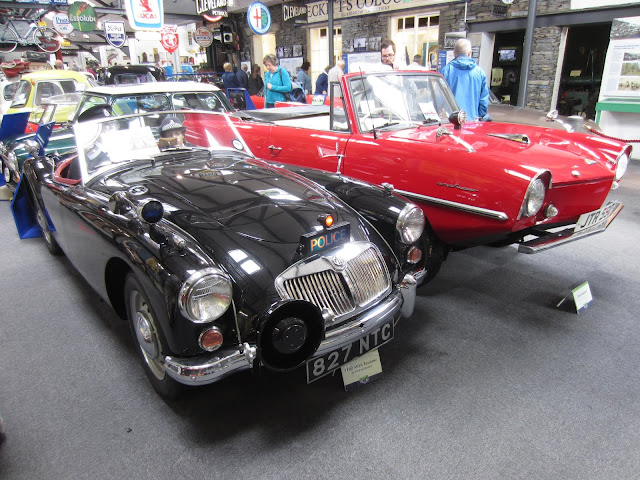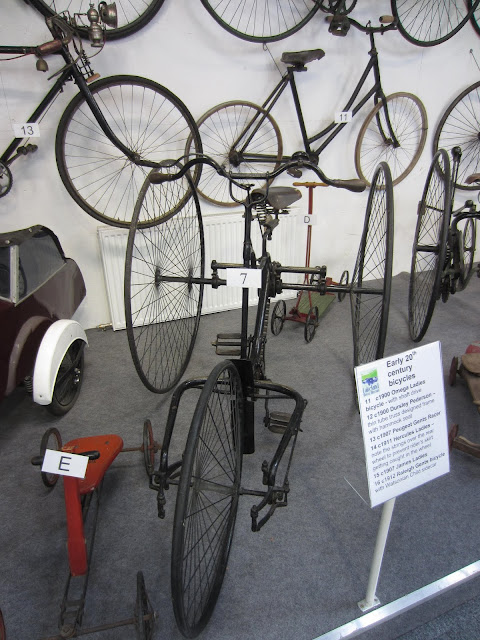
In the little village of Backbarrow, a short work from the ferry stop at Newby Bridge at the southern end of Lake Windemere, in the scenic Lakes District in the UK, is the Lakeland Motor Museum. The museum is relatively small and space is at a premium to display this collection of mainly British cars and motorcycles. The museum has a special display celebrating the achievements of Sir Malcolm and Donald Campbell and their world speed record attempts. The collection includes full sized replicas of the 1935 Blue Bird car, 1939 Blue Bird Boat K4 and 1967 jet hydroplane Bluebird K7. Unfortunately, the display was closed when we visited the museum in 2015, but it it worth a look.
https://www.lakelandmotormuseum.co.uk/collections/featured-collections/campbell-bluebird

The Lakes District is one of the UK's most popular tourist regions. The lakes and surrounding countryside are extremely pretty and there are lots of activities to keep you busy, ranging from walking through the hills, to water borne activities.

One of the ways to visit the Lakelands Motor Museum is to catch a ferry from Windemere. They leave regularly on scenic tours of the late, stopping at Newby Bridge at the southern end of the lake before turning around and heading back. You can buy a combined ticket for the ferry and museum.

In 2015 when we visited the Lakes District we sailed on the Teal, an old steamer still plying Lake Windemere.

The Lakeland Motor Museum is a short walk from the Newby Bridget ferry stop. It only takes ten or so minutes to walk. https://www.lakelandmotormuseum.co.uk/

The collection is mainly of British marques and, as I mentioned, the museum is collection is tightly packed in. The museum would benefit from an extension so that the collection can be better displayed, but we understand that such an undertaking isn't so simple.

View from the entrance. Say hello to the Citroen 5CV.

Citroen Traction Avant, introduced in 1936 featured front wheel drive and unitary body/chassis construction.

1933 Buick Eight CA

1937 Bentley 4

https://www.lakelandmotormuseum.co.uk/collections/featured-collections/motorcars/bentley-4-%C2%BC-standard-steel-park-ward-body

1899 Gailliardet Tricycle

De Dion Bouton

1913 Star 15.9 HP

BSA outfit and BSA Bantam behind

The 1950s and 60s.

The Italians doing what Italians do best - style. 1957 Ducati Sport 175cc

Austin A40


Messerschmitt KR201

BSA Bantam in HM Post Office livery

It seems like some Police forces in the English Midlands either had a bigger budget or better taste when purchasing police vehicles. 1960 MGA in police spec. Question - where do you put the perps?

Hans Trippel's amazing Amphicar.

Citroen 2CV Dayane and Triumph Vitesse

1961 Norton RAC service bike

The second most idiotic vehicle in history, the Peel 50.

Powered by a 50cc two stroke moped engine, the Peel could wheeze you around the suburban streets of the Isle of Man.

The East German 'people's car' - the Trabant P601

Invacar. Developed in 1948 as an invalid carriage for disabled people. The Invacars were constructed of fibreglass and powered by a 147cc Villiers two-stroke engine. Invacars were assigned by the National Health Service and were never privately owned. In 2003 the NHS recalled all Invacars and had them scrapped. A few however were 'lost' or made their way into private hands or museum collections. Maybe this one is parked right at the back to avoid the scrapper?

Vintage pedal cars

Bicycle collection

When it come to motive power, people tried all manner of bizarre ideas. How about a propeller powered tricycle?

Spacelander bicycle. http://www.voicesofeastanglia.com/2014/03/spacelander-space-age-cycle.html

Moped collection

Heinkel Perle moped

1920 Grigg motor scooter. Typical of the pre-war scooters with bare engine and basic functionality.

1923 Scootermotor

The Swallow Gadabout. Manufactured by the Swallow Motor Company, who built the original Jaguar sportscar and sidecars before the Second World War, introduced the Gadabout in 1949. It was a very basic machine with a two-speed gearbox. I was offered one for sale many years ago and after seriously considering it for a while, I turned it down. I regret that decision now as I think they're really interesting.

German luxury - Durkopp Diana

Another interesting British scooter BSA Sunbeam / Triumph Tigress.

Ariel 3. This bizarre three-wheeled delivery cart was the last product sold under the Ariel brand name in 1970. BSA had been developing the project since 1967 but were obviously not confident to launch it under their own name, so they revived the defunct Ariel name for the launch. It was a good idea as the Ariel 3 bombed. It wasn't helped by a confused advertising campaigned that promoted the vehicle with slogans such as "Here it is, whatever it is."

Lambretta LD

1961 Triumph Thunderbird with 'bathtub' bodywork.

The museum's large motorcycle collection is housed on a mezzanine floor overlooking the main collection.

Tricar delivery van.

The Flying Flea. These were a series of home built micro-aircraft designed by Frenchman Henri Mignot.

The 1980s display

MG TC

1934 Morris 10/4 Series 1

Motorcycles packed into a workshop

Another of the 1980s unsuccessful budget cars, the Bamby. Bamby developed the original Peel 50cc microcar prototype and then went on to manufacture their own 'improved' version. It really wasn't much of an improvement.

The DeLorean DMC. Designed by an American but built in Northern Ireland, the iconic stainless steel bodied car was a flop and quickly went out of business. Thanks to the 'Back to the Future' movies it is now one of the most recognizable cars in the world.


In the US you could buy 'buckboard' cars like this though mail order catalogues such the Sears-Roebuck. These 'do it yourself' kit cars were little more than a motorized go-kart, but in the country, where there was little traffic or road restrictions, they were a cheap and effective motor car.

Sinclair Personal Transporter. A disastrously ill thought out concept vehicle from the 1980s. With a top speed of 25 kilometres per hour, it was too slow to travel on the roads, it was too low to be safe, and its batteries were only capable of traveling for 30 kilometres before recharging. The Sinclair immediately flopped and only 5000 of the 25000 made were sold.